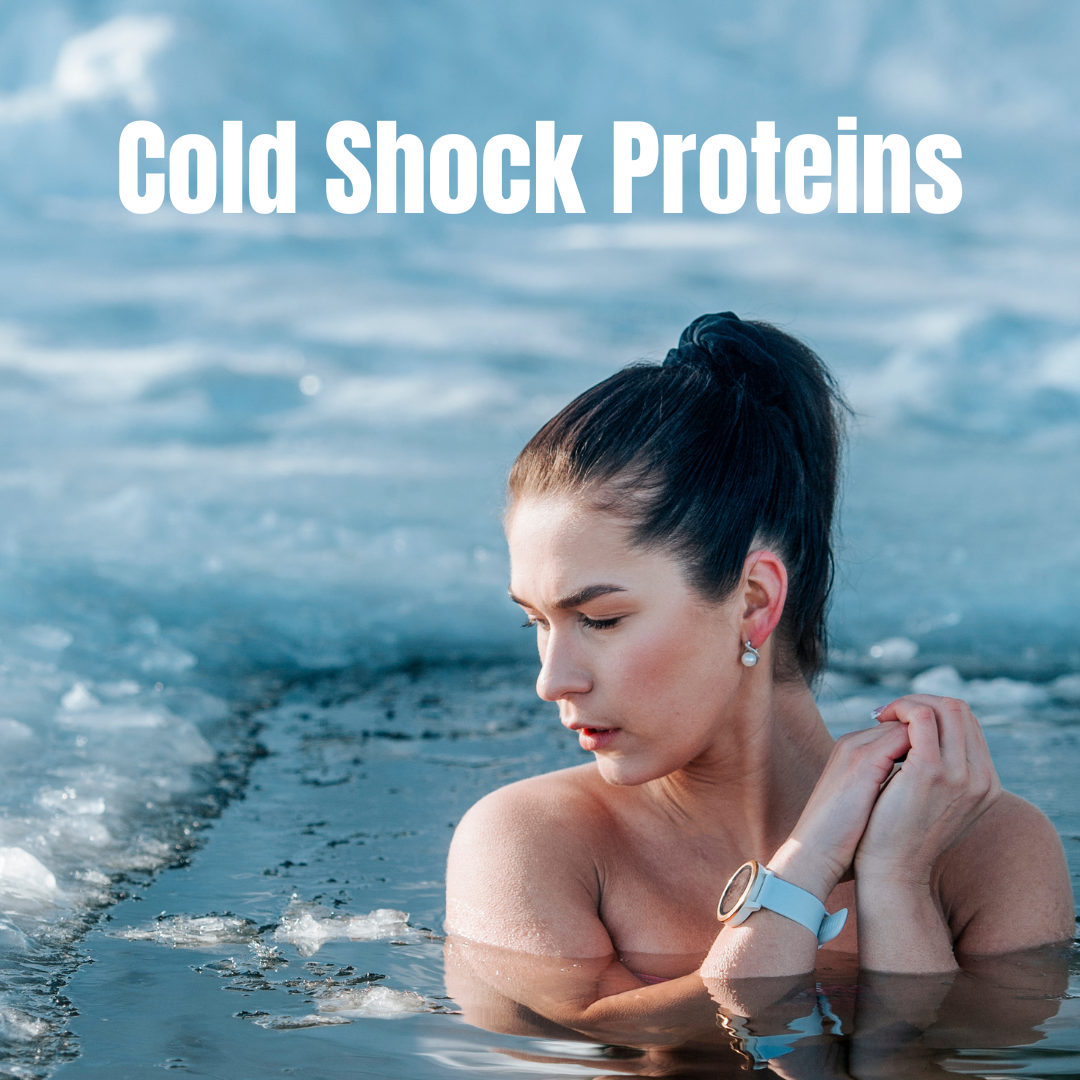
Cold Shock Proteins
Share
The Ultimate Guide to Cold Shock Proteins: Unlocking the Secrets of Cold Exposure
Cold shock proteins (CSPs) are gaining increasing attention in the wellness and health communities, thanks to a resurgence of interest in cold exposure therapies like ice baths, cold showers, and cryotherapy. Cold shock proteins are more than just a cellular response to cold - they are a crucial part of how our bodies adapt to environmental stress, offering a range of incredible benefits for our physical and mental well-being. In this comprehensive guide, we will take a deep dive into what cold shock proteins are, how they work, how they can be activated through cold exposure, and the numerous health benefits they provide. By the end of this post, you will understand why cold shock proteins might be the key to unlocking better health, enhanced resilience, and even longevity.
What Are Cold Shock Proteins?
Cold shock proteins (CSPs) are specialised proteins produced by cells when they experience a sudden drop in temperature. They are a natural protective mechanism that helps organisms survive cold stress by maintaining the stability and functionality of cellular processes. CSPs are a part of a larger family of stress-response proteins that include heat shock proteins (HSPs), but they are specifically activated during cold exposure.
One of the most well-researched CSPs is RNA-binding motif protein 3 (RBM3). Another important CSP is Cold-Inducible RNA-Binding Protein (CIRBP). These proteins help regulate cellular processes, preserve RNA stability, and ensure that cells can maintain essential functions even in extreme cold. While CSPs are found across many living organisms, including bacteria, plants, and humans, they play unique roles in adapting our bodies to the challenges of cold environments.
The Science Behind Cold Shock Proteins
Cold shock proteins are produced in response to a sudden drop in environmental temperature. This change triggers a cascade of molecular events that signal the need for protective mechanisms. Let's break down the science:
Cellular Response to Cold Stress
When our bodies are exposed to cold temperatures, cells undergo stress due to reduced enzyme activity and slowed biochemical reactions. Under these conditions, proteins are at risk of misfolding, and mRNA (the blueprint for protein production) becomes unstable. To adapt, cells initiate the production of cold shock proteins like RBM3 and CIRBP, which stabilise RNA and aid in proper protein synthesis.
Mechanism of Action
The primary role of cold shock proteins is to stabilise mRNA, ensuring that cells can continue to synthesise the proteins they need even under suboptimal conditions. CSPs bind to RNA, protecting it from degradation, and they also enhance protein synthesis - particularly the production of proteins that are critical for survival and cellular repair. By preserving cellular integrity and preventing the accumulation of damaged proteins, CSPs help ensure that cells remain healthy during and after cold exposure.
Neuroprotective Effects
One of the most exciting findings related to cold shock proteins is their role in neuroprotection. Studies have shown that RBM3, in particular, is involved in the regeneration of synapses - the connections between nerve cells - after cold exposure. This suggests that CSPs may play a role in protecting against neurodegenerative diseases such as Alzheimer's and Parkinson's. By enhancing synaptic plasticity, cold shock proteins could help delay cognitive decline and improve brain health.
How Are Cold Shock Proteins Triggered?
Cold shock proteins are triggered by sudden drops in temperature, typically through activities that expose the body to cold environments. These activities include:
1. Cold Showers
Cold showers are one of the easiest ways to stimulate cold shock proteins. A typical cold shower at a temperature of around 15°C (59°F) can activate CSPs. The sudden exposure to cold water stimulates the sympathetic nervous system, which in turn increases noradrenaline - a hormone linked to the activation of cold shock proteins.
2. Ice Baths
Ice baths are a more intense form of cold exposure, with water temperatures between 10–15°C (50–59°F). Ice baths not only stimulate CSP production but also reduce inflammation, improve recovery from exercise, and increase resilience to stress.
3. Cryotherapy
Cryotherapy involves standing in a chamber where temperatures can drop to as low as -110°C to -140°C (-166°F to -220°F) for a short period of time (typically 2-3 minutes). This extreme cold exposure triggers the production of CSPs, while also increasing endorphins, reducing muscle soreness, and boosting overall well-being.
4. Cold Water Immersion
Natural cold water immersion, such as swimming in cold lakes or rivers, is another effective method of activating cold shock proteins. This practice is gaining popularity for its profound effects on mental and physical health, from reducing anxiety to boosting immune function.
Health Benefits of Cold Shock Proteins
1. Neuroprotection and Brain Health
As mentioned earlier, cold shock proteins like RBM3 are believed to play a key role in neuroprotection. By enhancing synaptic regeneration and reducing neuronal death, CSPs could help protect the brain from neurodegenerative conditions. This has led researchers to explore CSPs as a potential therapeutic target for treating diseases such as Alzheimer's, Parkinson's, and other forms of dementia.
2. Enhanced Stress Resilience
Cold exposure, and the subsequent production of cold shock proteins, enhances the body’s ability to handle stress. This is an example of hormesis, where a small amount of stress leads to adaptive benefits. By increasing the production of CSPs, the body becomes better equipped to handle other stressors, which can improve mental and emotional resilience.
3. Reduced Inflammation
Cold shock proteins help to regulate inflammatory processes. Cold exposure leads to a reduction in pro-inflammatory cytokines and an increase in anti-inflammatory markers, making it a valuable tool for managing chronic inflammation. This anti-inflammatory effect is particularly beneficial for athletes seeking to reduce exercise-induced muscle soreness and for individuals with inflammatory conditions such as arthritis.
4. Muscle Recovery and Physical Performance
Athletes frequently use cold exposure as a recovery tool, and CSPs are a big part of the reason why. Cold shock proteins aid in muscle repair by reducing oxidative stress and preventing protein breakdown. The reduction in inflammation coupled with CSP activation helps muscles recover faster, allowing athletes to train more effectively and improve overall performance.
5. Metabolic Benefits and Fat Loss
Cold exposure can increase metabolic activity through a process known as non-shivering thermogenesis. Cold shock proteins contribute to the conversion of white adipose tissue (energy-storing fat) into brown adipose tissue (energy-burning fat), which is metabolically active. By increasing brown fat levels, CSPs can help boost metabolism and promote fat loss.
6. Longevity and Anti-Aging
The activation of cold shock proteins has been linked to increased autophagy, a process where cells clean out damaged components and recycle them for energy. Autophagy is crucial for maintaining healthy cells and preventing the accumulation of damaged proteins that contribute to ageing. By enhancing autophagy, cold shock proteins could potentially contribute to longevity and slow down the ageing process.
Practical Tips for Activating Cold Shock Proteins
If you are looking to reap the benefits of cold shock proteins, here are some practical tips for incorporating cold exposure into your daily routine:
- Start Gradually: If you are new to cold exposure, start with cold showers for 30 seconds and gradually work your way up. Over time, aim for 1-3 minutes of cold exposure.
- Incorporate Ice Baths: For a more intense activation of cold shock proteins, incorporate ice baths into your routine. Start with 1-2 minutes and work your way up to 5-10 minutes, depending on your tolerance.
- Practise Breathwork: Techniques like Connected Breathwork (deep inhale and slow exhale) can help you tolerate cold exposure more comfortably. Breathwork helps activate the sympathetic nervous system, which is linked to increased production of CSPs.
- Cold Water Swimming: If possible, engage in cold water swimming in natural bodies of water. The combination of physical activity and cold exposure is a powerful way to stimulate CSP production and boost overall health.
- Consistency is Key: To maximise the benefits, practise cold exposure regularly. Aim for 3-4 sessions per week for optimal results.
Potential Risks and Safety Tips
While cold exposure has many benefits, it’s essential to practise it safely to avoid adverse effects. Here are some safety tips:
- Listen to Your Body: Cold exposure can be intense, and it’s essential to listen to your body. If you feel dizzy, experience numbness, or have difficulty breathing, it’s time to exit the cold.
- Avoid Overexposure: Limit your cold exposure sessions to 5-10 minutes, especially if you are new to the practice. Overexposure can lead to hypothermia or other negative effects.
- Warm Up Properly: After cold exposure, warm up gradually. Use warm clothing, blankets, or a warm drink to help your body return to a normal temperature. Avoid using hot water immediately after an ice bath, as it can shock your system. Use the Wim Hof 'Horse Stance' method to effectively warm up naturally.
- Consult with a Doctor: If you have underlying health conditions, particularly cardiovascular concerns, consult with your healthcare provider before starting cold exposure practices.
Conclusion: Embrace the Power of Cold Shock Proteins
Cold shock proteins are a fascinating adaptation that allows our bodies to become more resilient in the face of stress. By incorporating cold exposure practices like cold showers, ice baths, cryotherapy, and cold water immersion into your routine, you can activate these powerful proteins and enjoy numerous health benefits - from enhanced brain health and muscle recovery to increased stress resilience and longevity.
Whether you are an athlete looking to optimise your recovery, someone seeking better mental health, or simply interested in living a longer, healthier life, cold shock proteins and cold exposure can offer a powerful tool for transformation. Start small, stay consistent, and experience the incredible benefits of unlocking the power of cold shock proteins.
Ready to take the plunge? Start your journey into cold exposure today and discover just how powerful your body can become with the right stimulus... why not sign up for a Wim Hof Method® Fundamentals workshop with me?
Relevant Scientific Studies on Cold Shock Proteins
Here is a list of some of the most relevant scientific studies on cold shock proteins, including links for further reading:
- RBM3 and Synaptic Protection: Malleret, G., et al. (2010). "Cold-induced RNA-binding protein RBM3 protects the brain from neurodegeneration." Journal of Neuroscience. Link
- Cold Shock Proteins and Neuroprotection: Peretti, D., et al. (2015). "RBM3 mediates structural plasticity and protective effects of cooling in neurodegeneration." Nature. Link
- Cold Exposure and Inflammation: van der Lans, A. A., et al. (2013). "Cold acclimation recruits brown adipose tissue in humans and increases nonshivering thermogenesis." Journal of Clinical Investigation. Link
- Cold Shock Proteins and Exercise Recovery: Ihsan, M., et al. (2016). "Post-exercise cold water immersion enhances recovery of dynamic muscle function: a meta-analysis." British Journal of Sports Medicine. Link
- CIRBP and Cold Stress Response: Zhang, Y., et al. (2011). "Cold-inducible RNA-binding protein (CIRBP) is involved in the regulation of inflammatory responses." Journal of Cellular Physiology. Link
- Cryotherapy and Cold Shock Proteins: Rose, C., et al. (2017). "Whole-body cryotherapy as a recovery technique after exercise: a review of the literature." Frontiers in Physiology. Link
These studies provide a solid scientific foundation for understanding the effects of cold shock proteins and cold exposure, as well as the benefits that can be derived from these practices. Dive into the research to learn more about the fascinating mechanisms behind CSPs and their impact on health.
